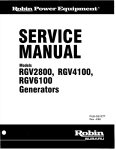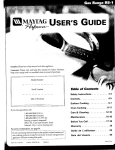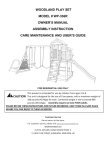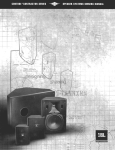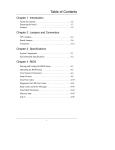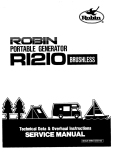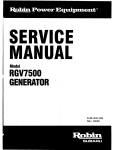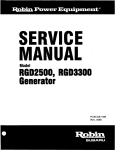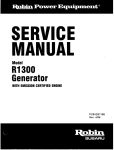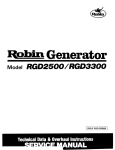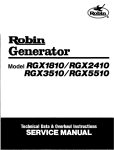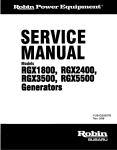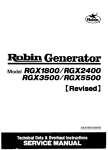Download RGV Series-Generator - Jacks Small Engines
Transcript
6 mEab IISSUE EM D-GS08591 E HRdi!!!I!@M GASOLINE ENGINE GENERATQ SERVICE MANUAL @FUJl HEAVYINDUSTRIESLTD. CONTENTS Title Section 1. SPECIFICATIONS 2. PERFORMANCE 3. FEATURES 4. GENERAL 4-2 4-3 Location of Serial Number and Specification Number . . . . . . . ...”...............”.. Construction 21 5-2 Function . . . . . . . . . . . . . . . . . . . . .." . . . . . . . . . . . . . . . . .." . . .."" . . . . . . . . .." . . . . . . . . . . . . . . . . . . . 21 5-3 Description of Generator Operation . . . . . . . . . . . . . . . . . . . . . . . . . . . . . . . . . . . . . . . . . . . . . . . . 25 8. MEASURING . . . . . . . . . . . . . . .." . . . . . . .." . . . . . . . . . . . . . . . . . . . . . . . . . . . . . . . . . . . . . 28 . . . . . . . . . . . . . . . . . . . . . . . . . . . . . . . . . . .." . . . . . . . . . . . . . . . . . . . ..- 29 ..".. ". . .." . . . . . . . . . . . . . . . . . . . . . . . . . . . . . . . . . . . . . . . . . . . . . . 32 8-1 Measuring Instruments . . . . . . . . . . . . . . . . . . . . . . . . . . . . . . . . . . . . . . . . . .. C. . . . . . . . . . . . . . . ..- 32 8-2 AC Output Measuring 8-3 Measuring Insulation Resistance . . . . . . . . . . . . . . . . . . . . . . . . . . . . . . . . . . . . . . . . . . . . . . . . ..- 35 CHECKING FUNCTIONAL MEMBERS ........ ...................................... Pilot LamP . . . . . . . . . . . . . . . . . . . . . . . . . . . . . . . ........ ....... .............................. 9-1 37 37 PRECAUTIONS OF APPLICATIONS PROCEDURES . . . . . . . . . . .." . . . . . . . . . . . . . . . . . . . . . . . . . . . . . . . . . . . . . ..". "........ 35 9-2 AC Receptacles . . . . . . . . . . . . . . . . . . . . . . . . . . . . . . . . . . . . . . . . . . . . . . . ... . . . . . . . . . . . . . . . . . . . . 37 9-3 Circuit Breaker . . . . . . . . . . . . . . . . . . . . . . . . . . . . . . . . . . . . . . . . . . . . . . . . . . . . . . . . . . . . . . . . . . . . . . . 38 9-4 Stator . . . . . . . . . . . . . . . . . . . . . . . . . . . . . . . . . . . . . . . . . . . . . . . . . . . . . . . . . . . . .. C. . . . . . . . . . . . . . . . . . 38 9-5 Rotor . . . . . . . . . . . . . . . . . . . . . . . . . . . . . . . . . . . . . . . . . . . . . . . . . . . . . . . . . . . . . . . . . . . . . .. C. . . . . . . . . 39 9-6 Condenser 39 9-7 ............................. ............... ............................... Diode Rectifier . . . . . . . . . . . . . . . . . . . . . . . . . . . . . . . . . . . . . . . . . . . . . . . . . . . . . . . . . . . . . . . . . . . . . . . Disassembly AND ASSEMBLY 40 . . . . . . . . . . . . . . . . . . . . . . . . . . . . . . . .. C. . . . . . . . . . . . . . . . . . 41 10-1 Preparation and Precautions . . . . . . . . . . .."... ".. ".. ". . . . . . . . . . . . . . . . . . . . . . . . . . . . . . . . 41 10-2 Special Tools for Disassembly and Assembly . . . . . . . . . . . . . . . . . . . . . . . . . . . . . . . . . . . . . 41 10-3 Disassembly Procedures . . . . . . . . . . . . . . . . . . . . . . . . . . . . . . . . . . . . . . . . . . . . . . . . . . . . . . . . . . . . 42 10-4 Assembly Procedures .." . . . . . . . . . . . . . . . . . . . . . . . . . . . . . . . . . . . . . . . . . . . . . . . . . . . . . . . . . . . . 51 10-5 Checking, Disassembly and Reassembly of the Control Box . . . . . . . . . . . . . . . ..--.. 58 Troubleshooting 11-1 NOTE: 21 Construction . . . . . . . . .." . . . .."... ". . . . . . .." . . ..". . . . . .." . . . . . . . . . .." . . . . . . . . . . . . . . . . . . RANGE 12. AND FUNCTION . . . . . . .."... ".- . . . . . . . . . . . . ..-. -C.---... -"--------- 20 5-1 7. 11. 1 3 DESCRIPTION SAFETY 10. . . . .." . . . . . . . . . .."... ". . ..".. "... ". . . . . . . . . . . . . . . . . . . . . . . . ..." . . . . . . . . . . . . . . . . . . .." . . . . .." . . .."... "". ". . . . . . . . . . . . . . . . . . . . . . . . . . . . .." . . . . . . . . . . . 5 6. 9. . . . . . . . . . .." . . ..". """ . . . . . ..".. "" . . . . . . . . . . . . . . . . . . . . . . .." . . .."" . . . . . . . . . CURVES OF THE GENERATOR . ..-”” .”... -. . ..”. o. . . . . . ..”...... 6 External View of Generator . . . . . . . . . . . . . . . . . . . . . . . . . . . . . . . . . . . . . . . . . . . . . . . . . . . . . . . . . . . 6 Control Panel . . . . . . . . . . . . . . . . . . . . . . . . . . . . . . . . . . . . . . . . . . . . . . . . . . . . . . . . . . . . . . . . . . . . . . . . . . 7 4-1 5. Page . . . . . .." . . . . . . .." . . . . . . . . . . . . . . . . . . . . . . . . . . . . . . . . . . . . . . . . . . . . . . . . . . 59 11-2 No AC Output . . . . . . . . . . . . . . . . . . . . . . . . . . . . . . . . . . . . . . . . . . . . . . . . . . . . . . . . . . . . . . . . . . . . . . . . 59 AC voltage is too high or too low . . . . . . . . . . . . . . . . . . . . . . . . . . . . . . . . . . . . . . . . . . . . . . . . . . . ’61 11-3 AC voltage is normal at no-load, but the load cannot be applied ..-. ---... ”...-”. 62 11-4 No DC Output . . . . . . . . . . . . . . . . . . . . . . . . . . . . . . . . . . . . . . . . . . . . . . . . . . . . . . . . . . . . . . . . . . . . . . . . 63 11-5 idle Control . . . . . . . . . . . . . . . . . . . . . . . . . . . . . . . . . . . . . . . . . . . . . . . . . . . . . . . . . . . . . . . . . . . . . . . . ..- 64 ...................................................................... 67 WIRING DIAGRAM As for the servicing information on engine portion, please EHI 7, EH25 and EH34 engine service manual. refer to the I 1. SPECIFICATIONS ! I I 3V I I UOlVNU3llV I i I I r I T i i j a, a D C a c U 8 c i - 1 - I T 3NIDN3 N N IoIo IncD -m .-C U ! I I I -r - L E E 0 a3 X w d a, X m In d (D I (D 0 0 0 > 0 PC 0 0 0 9 0 -I . , . IS :d : : T i C a, U S s I ! I j : ! I I ! I E E m b b X d m 0 X m 0 d I i N - I I i j ! I U n3 I a, n I . : 0 .c co 0 N m 0 I . : . s I I tlOlVNtl3llV 3N13N3 I I i i 7 ! - 2 - 2. PERFOMANCECURVES 63T \ 250 (1 25) 23ov/115v 220 /2 0 1 Rated 414 Load 50Hz (Hz) Hz 51 00 24ov/12ov 250 (1 25) 230V/115V 220 21 0 (1 0 5 ) 0 112 Rated Load -3- 414 DC OUTPUT DC Voltage DCAmpere DCoutput ........................ ........................ ........................ 12v 8.3A 1oow Thevoltagecurveshown in theleftindicatesthe characteristic of DC output when charging a battery. The voltagemay bedecreased by 20% whenthe resistance load is applied. NOTE: It is possible to use both DC and AC outputs simultaneously up to the rated output in total. C U R R E N T (AI& - 4 - 3. FEATURES 3-1 BRUSHLESS ALTERNATOR Newly developed brushless alternator eliminates troublesome brush maintenance. 3-2 CONDENSER TYPE VOLTAGE REGULATOR A trouble freecondensertypevoltageregulatorensuresastablevoltage underall working conditions. 3-3 OIL SENSOR Oil sensor automatically shutsoff the engine whenever the oil level falls down below the lower limit to protect the engine from seizure. 3-4 QUIET OPERATION Robin RGV series generator delivers a quiet operation with: 0 A large super silent muffler. 0 A quiet 4-stroke Robin Rro OHV engine. 0 A silent cyclone air cleaner. 3-5 NO RADIO NOISE Noise suppressor spark plug and spark plug cap are equipped standard interfe.rence. to prevent radio frequency 3-6 LARGE FUEL TANK The large fuel tank allows more than 5 to 11 hours of continuous operation which is sufficient for a half day or one day work without refueling. 3-7 RUGGED TUBULAR FRAME Full cradle type rugged tubuler frame protects the generator all around. 3-8 COMPACT AND LIGHT WEIGHT Newly developed brushless alternator enabled the light in weight. RGV generators to be very compact in size and 3-9 MINIMAL MAINTENANCE 0 0 0 0 0 0 A brushless alternator release the operator from periodical brush maintenance. A trouble free condenser type voltage regulator. A drip-proof alternator design. No-fuse circuit breakers. An electronic pointless ignition system. A dust-proof cyclone air cleaner. 3-10 LONG-LIFE DURABILITY The heavy-dut! 4 stroke Robin Rro OHV engine and virtually maintenance-free brushless alternator ensure greater durability with : 0 A brushless alternator with a condenser voltage regulator. Full rubber mount in a sturdy tubular frame. 0 A forged ste.el crankshaft supported by two main ball bearings. A pointless electronic ignition system. 0 A cast-iron cylinder liner. 0 A forged aluminum connecting rod. - 5 - 4. GENERAL DESCRIPTION OF THE GENERATOR 4-1 EXTERNAL VIEW of GENERATOR GAUGELEVEL FUEL VOLT?JETER STOP B U T O N CHOKE KNOB kC AIR CLEANER . . DC RECOIL STARTER , DC CIRCUIT BREAKEFi OIL SENSOR AC CIRCUIT BREAKER SPARK MUFFLER 31L DRAIN PLUG LEVEL OIL GAUGE -6- 4-2 CONTROL PANEL RGV2200, RGV2600 : SOHz, 60HZ-1lOV, 60Hz-120VTYPE RGV2200, RGV2600 : 50H~-220V,240V, 60HZ-220V TYPE -7- RGV2200, RGV2600 : SOHZ, 60H~-lIOV/220VDUAL VOLTAGE TYPE RGV2200, RGV2600, RGV4000 : U.K., 50H~-110V/120V[BS RECEPTACLE] -8- RGV2600 : U.S.A., 60Hz-120V [NEMA RECEPTACLE] RGV2200, RGV2600, RGV4000 : GERMANY, 50Hz-220V - 9 - RGV2200, RGV2600, RGV4000 : SOUTH AFRICA, 50HZ-220V I RGV2200, RGV2600, RGV4000 SWITZERLAND, 50HZ-22OV - 10 - RGV2200, RGV2600, RGV4000 : AUSTRALIA, 50HZ-240V RGV4000 : 5OHZ, 60Hz-11OV, 60HZ-120V TYPE - 11 - RGV4000 : 50H~-220V,240V, 60HZ-220V TYPE 0 RGV4000 : SOHZ, 6OHZ-l10V/220V TYPE - 12 - RGV4000 : U.S.A., 60H~-120V/240V [NEMA RECEPTACLE] @ . I RGV2200, RGV2600, RGV4000 : FRANCE, 50Hz-220V PRISES CA L CHARGE DE B A T T E R I E SEULEMENT - 13- 0 RGV6000 : 50Hz, 60Hz-1lOV, 60Hz-IiOV TYPE U VMEIER I @ 1 0 I 1 ! L ! RGV6000 : 50H~-220V,240V, 60Hz-220V TYPE f0 0 o\ 0 ~ O \ 0 0 ) - 14- RGV6000 : 50Hz, 60H~-llOV/220VDUAL VOLTAGE TYPE - 15 - . . RGV6000 : U.S.A., 60H~-120V/240V [NEMA RECEPTACLE] RGV6000 : GERMANY, 50Hz-220V f0 0 0 I O \ 0 - 16 - RGV6000 : SOUTH AFRICA, 50Hz-220V J h A U U , k E m I VMEtER I 63 0 RGV6000 : SWITZERLAND, 50Hz-220V f0 o\ 0 0 ON 0 - 17 - E RGV6000 : AUSTRALIA, 50HZ-240V 0 RGV4000, RGV6000 : (With optional electric starter and idle control) - la - RGV6000 : FRANCE, 5 0 H ~ 2 2 0 V VOLTMETRE 0 0 RGV4000, RGV6000 : (With optional electric starter and idle control) /@ P R l S E S CA - 19 - 4-3 LOCATION of SERIAL NUMBER and SPECIFICATION NUMBER Serial number and specification number are stamped on the LABEL (MODEL NAME) stuck on the end cover. NOTE: Always specify these numbers when inquiring about the generator or ordering spare parts in order to get correct parts and accurate service. MODEL NAME - 20 - 5. CONSTRUCTION AND FUNCTION 5-1 CONSTRUCTION E N D COVER MOUNT R U B B E R STATOR BOLT R E A R COVER ROTOR COMPLETE BALL BEARING T H R O U G H BOLT SUPPORT STATOR COMPLETE RING FRONT C O V E R Fig. 5-7 5-2 FUNCTION 5-2-1 STATOR I Thestatorconsists of alaminatedsiliconsteel sheet core, a main coil and a condenser coil which are wound in the core slots. excites Thecoil condenser coil field the rotor which generates AC voltage in the main coil. i -II i 1 I I Fig. 5-2 - 21 - 5-2-2 CONDENSER One or two condensers are installed in the control box and are connected to the condenser coil of the stator. Thesecondensersandcondenser coilregulatethe output voltage. : 5-2-3 ROTOR The rotor consists of alaminatedsiliconsteel sheet core and a field coil which is xound over the core. DC current in the fie.ld coil magnetizes the steel sheet core. Tw~opermanent magnets are provided for the primary exciting action. Fig. 5-4 A diode rectifier and surge absorber is mounted insideof the insulator. ! 1 ! . - 22 - 5-2-4 DC CIRCUIT BREAKER j (1) The 10 ampere DC circuit breaker mounted on thecontrolpanelprotectswhole DC circuit fromgettingdamage by overloadorshort circuit. Fig. 5-6 5-2-5 NO-FUSE BREAKER The no-fuse breaker protects the generator from getting damage by overloading or short circuit'in the appliance.Table 5-1 shows the capacity of no-fuse breaker by each spec. and their objectof protection. I 1 MODEL RGV2200 I SPECIFICATION NO-FUSE BREAKER 50HZ-11OV 12A Total output amperage 60Hz-11OV, 120v 15A Total output amperage 50HZ-11OVI22OV 60HZ-120VI240V I ' 6.5A (2-Pole, 2-Element) (2-Pole. 8A 2-Element) I 50HZ-11OV. . OV. 12Ov . . 60HZ-240V . . 50HZ-11 OVl220V i 60Hz-11OVi22OV, 12OVi24OV 50HZ-11OV 60142-1lov, 120v I . 15A RGV4000 . RGV6000 . Total output amperage Total output amperage . 50Hz-220V ! 27A j 30A . I I 14A (2-Pole, 2-Element) [ 15A (2-Pole, 2-Element) 40A ! 50HZ-240V 50HZ- 11OV/22OV. 60HZ- 11OVi22OV. 60Hz-120Vi240V . Total amperage output 1 Total output amperage amperage Total output Total output amperage Total output amperage Total output amperaqe 1 Total outputamperage Total output amperage 20A Total output amperage 30A 23 - amperage Total output Output from30A receptacle 18A Table 5-1 ! i 30A 20A (2-Pole. 2-Element) - amperage Total output amperage .12A -5OHZ-240V 50HZ-11 OVi220V Total output Total output amperage 14A 50HZ-220V. 60Hz-220V I aA I I 50HZ-11OV 60HZ-11OV. 120V I . 1 OA (2-Pole. 2-Element) I .60Hz-11OV!22OV. 120V!240V I Total output amperage . !i 9A (2-Pole. 2-Element) I 60HZ-220V ! Total output amperage 9A RGV2600 Total output amperage 18A 1OA I ' 20A 60HZ-11 50Hz-220V . I Total output amperage 8A 60HZ-220V I I OBJECT of PROTECTION 6.5A 50HZ-220V, 240V Total output amperage ' ~ j I Total amperage output Total output amperage ifrom Output 30A receptacle 60HZ-220 5-2-6 RECEPTACLE and AC PLUG (STD.SPEC.) These are used for taking AC output power from the generator. A total of five kinds of receptacles, each varying in rated voltage and current from another, are used. Each model has at least one receptacle to delivertheratedgeneratoroutput. As many AC plugsasthereceptacles,eachmatchingthe corresponding receptacle, are provided. Table 5-2 shows the rated current for each receptacle. Be careful not to use the receptacles andAC plugs beyond the specified amperage limitsto prevent burning. I I up to 30 amperes (See Caution.) I I Table 5-2 Caution: To connect the appliance to locking receptacle, insertthe plug intothe receptacle and turn it clockwise to lock. Fig. 5-7 NOTE: If your generator has receptacles peculiar to your country, Table 5-2 does not apply. NOTE: The generator for U.S.A. market is equipped with NEMA standard receptacles shown in table 5-3. Use the proper plug for connecting appliance to the generator. Style Ampere Receptacle AC plug 125V 20A NEMA NEMA 5-20R 5-20P NEMA L14-20R L14-20P NEMA NEMA L5-30P Table 5-3 - 24 - Description GFCl (Ground Fault Circuit Interrupter) Receptacle, duplex Locking Receptacle Locking Receptacle 5-3 DESCRIPTION Of GENERATOR OPERATION PERMANENT MAGNET FOR INITIAL EXCITATION STATOR COIL MAIN . RECEPTACLE SURGE ABSORBER "'_I Fig. 5-8 5-3-1 GENERATION Of NO-LOAD VOLTAGE When the generator starts running, the permanent magnet built-in to the rotor generates 3 to 6V of AC voltage in the main coil and condenser coil woundon the stator. As one or two condensers are connected to the condenser coil, the small voltage at the condenser which flows through the condenser coil. At this time: a small flux coil generates a minute current isproducedwithwhichthemagneticforce at therotor's magnetic pole is intensified.Whenthis magnetic force is intensified, the respective voltages in the main coil and condenser coil rise up. As the current increases, the magnetic flux at the rotor's magnetic pole increases further. Thus the voltages at the main coil and condmser coil keep rising by repeating this process. As AC current flows through the condenser coil, the density of magnetic flux in the rotor changes. This change of magnetic flux induces AC voltage in the field coil, and the diode rectifier in the field flows through the field coil and coil circuit rectifies this AC voltage into DC. Thus a DC current (8 magnetizes the rotor core to generate an output voltage in the main coil. When generator speed reaches 2700 to 2800 rpm (50Hz type) or 3000 to 3300 rpm (60Hz type), the current in the condenser coil and field coil increases rapidly. This acts to stabilize the output voltage of each coils. If gene.rator speed further increases to the rated value, the generator output voltage will reach to the rated value. !z :s 5-3-2 VOLTAGE FLUCTUATIONS UNDER LOAD When the output current :g flows through the main coil to the appliance, a magnetic flux is produced and serves to increase current in the condenser coil. When current 8 3 increases, the density of magnetic flux across the rotorcorerises. As a result,thecurrent flowing in thefield -coilincreasesand the generator output voltage is preventedfrom decreasing. z ;n - - 25 - i 5-3-3 FULL POWER SWITCH (Dual Voltage Type) The full power switch is provided for the dual voltage type receptacle in each voltage. to take out the full rated power from one 1201240V 11OI220V) r "-:(or I 240V (or 220V) 43l Fig. 5-9 MC, - I Rec. 1 1 Fig. 5- 10 Switch : Position I ll0V or 120v 1 10:'220v or 120i240V LOWER VOLTAGE RECEPTACLE I : Rated output I Half of rated output - - 26 - No output can be :aken. Rated output 1 Table 5-4 " HIGHER VOLTAGE RECEPTACLE : I I 1 Two main coils are wound over stator core. Each main coil outputs half the rated power at the 1owe.r voltage (llOV or 120V). These main coils are wound to be in the same phase. The full power switch reconnects these main coilsin parallel or in series. Fig. 5-9 shows a circuit diagram.When the full power switch is set for single lower voltage indication (11OV or 12OV), the switch position is as indicated by the lower solid line in the diagram. Fig. 5-10 is a simplified representation of this circuit, showing the two main coils connected in parallel.In this case, the higher voltage -(220V or 240V) at Rec. 3 cannot be taken out. Rec. 2 for the lower voltage can output up to the rated power (up to 30A if the rated current is over 30A), and Rec. 1 can output up toa total of 15A. When the full power switch is set for double voltage indication (110V/220V or 120V/240V), the switch position is as indicatedby the upper dotted line in Fig. 5-9. Fig. 5-11 is a simplified representation of this circuit, showing the two main coils connectea in series. In this case, power can be taken simultaneously from the receptacles for the both voltages. Rec. 3 for the higher voltage can output up to the rated power, but Rec. 1 and Rec. 2 for the lower voltage can output only up tohalf the rated power each. Table 5-4 is a summary of the above explanation. Select the proper output voltageby full power switch in accordance with the appliance to be used. 5-3-4 VOLTAGE CHANGEOVER SWITCH The generator of 50Hz 110V/220Vdualvoltagetypefor U.K. isprovidedwithvoltagechangeover switch instead of full power switch. The output voltage is selected from llOV and 220V by turning this switch and both voltages cannot be taken out simultaneously. VOLTAGE CHANGEOVER SWITCH 11ov RECEPTACLE PTACLE - - Fig. 5-12 - 27 - 6. SAFETY PRECAUTIONS 1. Use extreme caution near fuel. A constant danger of explosion or fireexists. Do not fill the fuel tank while the engine is running. Do not smoke or use opern flame near the fuel tank. Be careful not to spill fuel when refueling. If spilt, wipe it and let dry before starting the engine. 2. Do not place inflammable materials nearthe generator. Be careful not to put fuel, matches, gunpowder, oily cloth, straw, and any other inflammables near the generator. 3. Do not operate the generator in a room,cave or tunnel. Always operate in a well-ventilated area. Otherwise the engine may overheat and also, the poisonous carbon monoxide containedin the exhaust gases will endanger human lives. Keep the generator at least 1 m (4 feet) away from structures or facilities during use. 4. Operate the generator on a level surface. If the generator is tilted or moved during use, there is a danger of fuel spillage and a chance that the generator may tip over. 5. Do not operate with wet hands or in the rain. Severe electric shock may occur. If the generator is wet by rain or snow, wipe it and thoroughly dry it before starting. Don't pour water over the generator directlynor wash it with water. If the generator is wet with water, the insulations will be adversely affected and may cause current leakage and electric shock. 6. Do not connect the generator to-the commercial power lines. This may cause a short-circuit or damage to the generator.Use a transfer switch for connecting with indoor wiring. NOTE: The parts numbers of shown in Table6-1. the transfer switches and of the plastic box to store them are as ! Part No. j ! , 340-45606-08 j 367-43008-08 ' Q'ty Transfer Switch 365-45604-08 367-45605-08 Part Name I I 348-43009-08 j Transfer Switch I I ! ' Phase Allowable Current 1 1 15A 1 1 30A Transfer Switch 1 Plastic Box 1 Plastic Box 1 j 1 1 ' i 1 j i 60A 30A 60A Table 6-7 7. Be sure to check and remedy the cause of circuit breaker tripping before re-setting it on. CAUTION :If the circuit breaker tripped off as a result of using an electrical appliance,the cause can be an overload or a short-circuit. In such a case, stop operation immediately and carefully check the electrical applianceand AC plugs for faulty wiring. - 28 - 7 . RANGE OF APPLICATIONS Generally, the power rating of an electrical appliance indicates the amount of work that can be done by it.The electric power required for operating an electrical appliance is not always equaltotheoutput wattage of the appliance. The electrical appliances generally have a label showing their rated voltage, frequency, and power consumption (input wattage). The power consumption of an electrical appliance is the power necessary for using it.When using a generator for operating an electrical appliance,the power factor and starting wattage must be taken into consideration. In order to determine the right size generator, it is necessary to add the total wattage of all appliances to be connected to the unit. Refer to the followings to calculate the power consumption of each appliance or equipmentby its type. Incandescent lamp, heater, etc. with a power factor of 1.O Total power consumption must be equal to or less than. the rated output of the generator. Example: A rated 3000W generator can turn thirty lOOW incandescent lamps on. Fluorescent lamps,mercury lamps, etc. with a smaller power factor Select a generator with a rated output equivalent to 1.2 to 2 times of the power consumption of the load. Example: A 400W mercury lamp requires 600W to 700W power source to be turned on. A rated 3000W generator can power four or five 400W mercury lamps. NOTE1: If a power factor correction capacitor is not applied to the mercury lamp or fluorescent lamp, the more powershall be required to drive those lamps. A rated 3000 W generator candrive one ortwo 400 W mercury lamps without power factor correction capacitors. of the fluorscent lamp generally indicates the output wattage of the NOTE2: Nominal wattage lamp. Therefore, if the fluorescent lamp has no special indication as to the power consumption, efficiency shouldbe taken into accountas explained in Item (5) on the following page. Motor driven tools and light electrical appliances Generally the starting wattage of motor driven tools and light electrical appliances are 1.2 to 3 times lager than their running wattage. Example: A rated 250W electric drill requires a 400W generator to start it. Initially loaded motor driven appliances such as water pumps,compressors,etc. These appliances require large starting wattage which is 3 to 5 times of running wattage. Example: A rated 900W compressor requires a 4500W generator to drive it. NOTEi: Motor-driven appliances require the aforementioned generator output only at the starting. Once their motors are started, the appliances consume about 1.2 to 2 times their rated power consumption so that the excess power generated by the generator can be used for other electrical appliances. NOTE2 Motor-drivenappliancesmentioned in ltems (3) and (4) vary in theirrequiredmotor startingpowerdependingonthekind of motor and start-upload. Ifitis difficult to determine the optimum generator capacity,select a generator with a larger capacity. - 29 - (5) Appliances without any indication as to power consumption Some appliances have no indication as to power consumption; butinsteadtheworkload(output) indicated. In such a case, power consumption is to be worked out according to the numerical formula mentioned below. is (Output of electrical appliance) = (Power consumption) (Efficiency) Efficiencies of some electrical appliances are as follows: Single-phase motor - - - - - - . . - - - - - - 0.6 0.75 0.65 0.9 Three-phase motor -- --------Fluorescent lamp . . . . . . . . . . . . . . . . . . . 0.7 - 0.8 - The smallerthe motor, the lower the efficiency. is 40W. Its efficiency is 0.7 and accordingly, power consumption will be 40 + 0.7= 57W. As explained in Item(2), multiply this power consumption value of 57W by 1.2 - 2 and you will get the figure of the necessary capacity of a generator. In other words, a generator with a rated output of 1000Wcapacity can light nine to fourteen 40W fluorescent lamps. Example 2: Generally speaking, a 400W motor means that its work load is 400W. Efficiency of this motor is 0.7 and power consumption will be 400 + 0.7= 570W. When this motor is used for a motor-driven tool: the capacity of the generator should be multiple of 570W by 1.2 to 3 as explained in the Itern(3). 570(W) X 1.2-3=684(W)-1710(W) Example 1: A 40W fluorescent lamp means that its luminous output I MODEL - 50HzFrequency lncandesent lamp, heater, etc. Fluorescent lamp, mercury lamp, etc. i 1 1 14OOW approx. 700W 60Hz 50Hz 60HZ I 1800W 2000w 2200w 1 I approx. 9OOW approx. approx. 400W ' 400W Pump. compressor, etc. approx. 300W i I I 50Hz ! 60Hz 3000W j 3500W I I I I approx. approx. lOOOW j 1100W I I approx. approx. 800W I 1 I ! I Electric tool etc. I RGV2600 i I I I I RGV6000 RGV2200 RGV4000 1I approx. approx. approx. approx. approx. approx. 400W 400W 1i 1 I 400W Table 7-1 - 30 - :i 1 50Hz 4400W I II 60Hz 4800W I approx. 2000W 1800W \ approx. 1600W 1! approx. approx. 16OOW 18OOW 750W I i 1 750W 'i i I 1 approx. 1500W I approx. 800W 1 800W I approx. 2350W j approx. I 2000W 1 app:ox. 800W NOTES: Wiring between generator and electrical appliances 1. Allowable current of cable Use a cable with an allowable current that is higher than the rated input current of the load (electrical appliance). If the input currentis higher than the allowable current of the cable used, the cable will become excessively heatedand deteriorate the insulation, possibly burning. it out. Table 7-2 shows cables and their allowable currents for your reference. 2. Cablelength If a long cable is used, a voltage drop occurs 'due to the increased resistance in the conductors decreasing the input voltage tothe load (electrical product). As a result, the load be candamaged. Table 7-2shows voltage drops per100 meters of cable. TI Nominal cross I mm2 No. 1 No. l m m Qil00m 1 3010.18 2.477 2.5V 12 16 50 / 0.18 1.486 1.5V 5V 17 i 3710.26 0.952 A I 0.75 7 18 1.27 2.0 8 13 i I Resistance dia. 11I I1 Flowing Current 1A 5.5 1 12-10 10-8 I 0.517 45 10.32 23 5A 8A 10A - - 7.5V 12V 15V 5V 8V 1 1OV 4~ 1 5~ , 12.5V 8V 1 I 1V 1 j ! 1 . 5 ~j 2.5V I 3.5 3A - 3V I 25 70 10.32 0.332 I , I - 1V I ! 2V I I I 2.5V 3.5V Table 7-2 1 V = 100 X R X I X l R means resistance ( 0 !lo0 m) on the above table. Voltage drop indicates as I means electric current through the wire (A). 8 means the length of the wire (m). The length of wire indicates round length,it means twice the length from generator to electrical tools. - 31 - 8. MEASURINGPROCEDURES 8-1 MEASURING INSTRUMENTS 8-1-1 “Dr. ROBIN” GENERATOR TESTER The“Dr.Robin”generatortester is exclusively designedforfast,easydiagnosisandrepair of. Robin generators. The “Dr. Robin” has the following features: (1) Functions of voltmeter, frequency meter, meggertester,capacitancemeterandcircuit tester are combined in one unit. (2) Fast and easy readout by- digital indicator. (3) Built-in automaticbatterycheckerindicates the time to change batterie.s. (4) Tester and accessories are installed in a handy, sturdy case for easy carring. 0 Fig. 8-1 SPECIFICATIONS - Model I Dr. Robin ~ Part Number 388-47565-08 0-5OOV AC Voltage Q) p! , [r 25-70HZ Frequency m 1 Resistance .G - 0.1 -1.999 Q L 3 m 10-1 00 ,E F Condenser Capacity m a, I z I 3M R lnsuiation Resistance _____ Circuit Protector 1 Power Source I I Accessories Dimensions (L X W Fuse 2 x 6F44P(006P) Dry CellBattery Testleadswith needie probes . . ‘ 1 set Test leads with jack plugs . . . . . . 1 set X H) i 285 mrnx200 r n m x l 1 0 rnrn 1.6kg Weight Table 8- 1 The “Dr. Robin”generator tester can number. be ordered from Robin generator distributors by the following part I Dr. Robin Part Number : 388-47565-08 I If you do not have a ”Dr. Robin“generator tester,use the instruments described in the following section for checking generator parts. - 32 - 8-1-2 INSTRUMENTS (1) VOLTMETER AC voltmeter is necessary.Theapproximate ACvoltageranges of the voltmeters to be used forvarioustypes of generatorsareas follows: 0 to 15OV: Typewithanoutputvoltage of 110 or 120V 0 to 300V: Type withanoutputvoltage of 220,230 or 240V 0 to 15OV, 0 to 330V: Dual voltage type -. ””- I F O R AC Fig. 8-2 (2) AMMETER ACammeter is necessary.AnACammeter with a range. that can be changed according to the current rating of a given generator is most desirable. (About 10A, 20A, 100A) FOR AC Fig. 8-3 FREQUENCY METER Frequency range : About 45 to 65Hz ! NOTE: Be careful of the frequency meter’s input voltage range. ., r I Fig. 8-4 - 33 - (4) CIRCUITTESTER Used for measuring resistance, etc. Fig. 8-5 TESTER ( 5 ) MEGGER Used for measuring generator insulation resistance. Select one with testing voltage range of 5OOV. ! I Fig. 8-6 (6) ENGINETACHOMETER There are various types of tachometers, such as contactlzss type,contacttype,andstrobe type. The contact type can be used only when the generator and engine have been disassembled.Thecontactlesstype is recommended. The PET-2100E engine tachometer is available from your Robin distributors. Please inquireby the part number PET-2100E. I I ! I ! Fig. 8-7 - 34 - 8-2 AC OUTPUT MEASURING TO AC RECEPTACLE Fig. 8-8 Use a circuit like the shown in Fig.8-8 for measuringAC output. A hot plate or lamp with a power factor of 1.0 may be used as a load. Adjust the load and rpm. and check that the voltage range is as specified in Table 8-2 at the rated amperage and rated rpm. Rated voltage Voltage range 120v 110v 99-121V 220v 240V 21 6-264V 198-242V 108-1 32V Table 8-2 8-3 MEASURING INSULATION RESISTANCE Use a "Dr. Robin"generator tester in megger tester mode or use megger a tester to check the insulationresistance.Connectameggertesterto one of receptacle. output terminals and the ground terminal,thenmeasuretheinsulationresistance. An insulation resistance of 1 megohm or more is normal. (The original insulation resistance at the time of shipment from the factory is 10 megohm or more.) If it is less than 1 megohm,disassemblethe generator and measure the insulation resistance of the stator, rotor and control panel individually. 0 STATOR (1) Measure the insulation resistance between BLUE lead and the core. (2) Measure the insulation resistance between WHITE lead and the core. (3) Measure the insulation resistance between YELLOW lead and -the core. (4) lMeasure the insulation resistance between BROWN lead and the core. Fig. 8-10 - 35 - . 0 .. ROTOR Measure the insulation across one of the soldered terminals of the rotor and the core. I I Fig. 8- 1 1 0 CONTROL PANEL Measure theinsulationresistancesbetweenthe live parts and the grounded parts. Any part where the insulation resistance is less than 1MQ has faulty insulation, and may cause electric leakage and electric shock. Replace the faulty part. - 36 - 9. CHECKING FUNCTIONAL MEMBERS 9-1 PILOT LAMP and VOLTMETER Checkthepilotlampandthevoltmeter if it is turned on by applying specific voltage. Pilot lamp and voltmetercannotbechecked with circuittesterbecauseitsresistanceistoolarge. (See Fig.9-1.) I ' Fig. 9-1 Pilot lamp should be turnedon at 70 to 12OV. 9-2 AC RECEPTACLES Using a "Dr. Robin"or a circuit tester, check continuity between the two terminals at the rear of the AC receptacles while the receptacle is mounted on the control panel. When continuity is found between the output terminals of the rece.ptacle with a wire connected across these terminals, the AC receptacle is normal. When the wire is removed and no continuity is found between these terminals, the receptacles are also normal. & .: I .I: Fig. 9-28 Fig. 9-2A - 37 - AC RECEPTACLE I 9-3 CIRCUIT BREAKER Check continuity between each of two terminals at the rear of the circuit breaker while it is mounted on the control panel. Normally, there is continuity be.tween each of the two when the circuit breaker is on while there is no continuity when the circuit breaker is off. . . . . . Fig. 9-3 . 9-4 STATOR Disengage connectors on the wires from stator and checktheresistancebetweenwireswitha"Dr. Robin" or a circuit tester refering to the following table. Fig. 9-4 (Rxl!! +lo%) I I i . . I . I ' RGV2200 . . . . . 60 I . r;n 4" ' .j RGV6000 . . . . .. r . i 120V, 120Vi240V 110V. 220V. 110Vj220V I . :: 60 . ! . 240V ! 1.24 1.24 1.24 1.24 1.oo 1.oo 120vi240v 120v. ~ . i 0.33 ! I 0.39 0.24 Yellow iYellow 4.48 4.48. 0.75 . . . I . 0.70 . I __ j 0.75 - 3.46. Table 9-1 . 2.64 . . .! 1;99. : 1.99 - ! 1. 0.54 j 0.54 i 0.39 0.56 0.24 . " . ! . -, : 1.19 I 1:44 0.83 0.33 . .. . 3.46 . 2.64 0.75 0.70 0.54 11ov. 220v. 11ovi220v , 2.33 1.44 - 220v. 1lOV/220V . 0.75 . I .. I 1.96 2.33 240V 50. . 1.19 220v, 11OV:'220V I -1 OV/220V 240v 220v. 11OV!220V -60 j 0.54 120V/240V 120V. .. . .I 0.83 ' 1 . jI CondenserWinging I Black! Blue 1.96 1~ O VI . ~ O V ~ ~ ~ O V 11ov. 220v, 11 I I RGV4000 I 50 RGV2600 j - White / Red OVl22OV 1.1 240V 220V,~ llOV/220V ! 60 iI II 11ov, 220v, 50 I . , AC Winding Specification Voltaae I Hz 1.03 I ' -1.03 0.79 0.79 0.24 . . . . -0.24 -0.56 :. . NOTE:- If--the--circuit tester is not sufficiently accurate, it may not show the values given and may give erroneous readings. Erroneous readings will also occur when there is a wide variation 0-f resistance among coil at ambient temperatures different from ZO"C(68"F). windings or when measurement is performed - 38 - 9-5 ROTOR ASSEMBLY (1) Using a "Dr. Robin" or a circuit tester, measure the resistance of the field coil at the terminals. (RxlQ &lo%) MODEL RESISTANCE I RGV2200 RGV2600 RGV4000 RGV6000 2.52 R 2.04 R 1.77R 1.60 R I Table 9-2 NOTE 1: Because a diode is soldered to the coil ends at the terminals, resistance may be measured only when tester probes touche the terminalsinonecombinationofpolarity.Therefore,ifnoresistance reading appears, try checking in reverse polarity. NOTE 2: Ifthe circuit testerisnotsufficiently accurate,itmaynotshowthevalues given and may give erroneous readings. Erroneous reading will also occur when there is a wide variation of resistance among coil windingsorwhenmeasurement is performed at embient temperatures different from2OoC(68"F). 9-6 CONDENSER W Use a "Dr. Robin" in capacitance meter mode to check the capacity of condensers. (See Fig.9-6). 3 RGV4000, RGV6000 I Fig. 9-6 NOTE: Be sure to discharge condensers by shorting condenser leads each other before checking their capacitance,or the accurate reading cannotbe obtained. - 39 - I W NORMALCAPACITY OF CONDENSER MODEL RGV2200 Resistance RGV2600 17~F . RGV6000 202FX2 24kF RGV4000 282FX2 Table 9-3 I If such an instrument is unavailable, the condenser can be checked by replacing with a new one. If thegeneratorperformsgoodwithnewcondenser,thecause of trouble is defect in original condenser. . - .. 9-7 DIODE RECTIFIER DIODE RECTIFIER Brown Brown/ Orange White . . Brown Brown Brown CIRCUIT TESTER ~. Fig. 9-9 . . . Fig. 9-10 .. Circuit -inside of the diode rectifiers is as shown in Fig. 9-9. Check continuity between each terminal using a circuit tester as shown in Fig. 9-10. The rectifier is normal when condtinuity is as follows: . W ... . Checking table. for . analogue c.ircuit tester. Analogue. circuit tester Ii I I I b! ! .. .. . : . Apply black Brown I Brown I Apply red 3 .needle -of ttie circuit tester Brown Orange Brown;White i Sneedle of the circuit tester Brown Continuity I No continuity j i I I - 40 - Brown:White Continuity . . N O continuity Continuity I , Continuity No continuity i Orange - No continuity j No continuity r-" No continuity I i . j Continuity ?"-..,I No continuity W Checking table for digital circuit tester. Apply red @ J needle of the circuit tester Digital circuittester Brown Brown Apply black@ needle of the circuittester - Brown Orange 1 N O continuity ! Brown,White Brown Orange BrownWhite No continuity No continuity Continuity No continuity Continuity 1 Continuity Continuity No continuity No continuity Continuity I No continuity Table 9-4-2 NOTE 1: Because of the difference of measuring method between the analogue circuit tester and the digital circuit tester, polarityof tester needles should be reversed. NOTE 2: “Continuity” means forward direction characteristics of the diode, and different from short circuit condition (in which apointerof the testergoes out ofits normal scale),shows resistanceto some extent. Whenresults of thecheckingindicatesfailureeveninone section,replace with anew one. NOTE 3: Some analogue testerslike “Simpson” brand operate assame as digital testers. 10. DISASSEMBLY AND ASSEMBLY 10-1 PREPARATION and PRECAUTIONS 1) Be sure to memorize the location of individual parts when disassembling the generator so that. the generator can be reassembled correctly. Tag the disassembled part with the necessary information to facilitate easier and smoother reassembly. 2) For more convenience,divide the parts into several groups and store them in boxes. 3) To prevent bolts and nuts from being misplaced or installed incorrectly, replace them temporarily to their original position. 4) Handle disassembled parts with care; clean them before reassembly using a neutral cleaning fluid. 5 ) Use all disassembly .‘assembly tools properly, and use the proper tool for each specific job. 10-2 SPECIAL TOOLS for DISASSEMBLY and ASSEMBLY Part Number : 388-95001-07 PartName R E A R COVER PULLER - 41 - : REARCOVERPULLER Step Part to remov . I Description .. Remarks Tool ' . - Front Panel ..- . (1) Take off the four bolts and remove the .. . . - t -1 . - ~ 10 mm spanner or box wrench front panel from the frame. (See Fig. 10-1.) . (2) Disconnect the connectors on the wiring beween the-front paneland the engine. (SeeFig. 10-2.) . . . - . - ti ~~ - . . .. .. . . . .- . .." . ,. - . .... . . . . i . . . . Fig. 10-1 (.3) Take off the bushing from the bottom of .. - . . .- the front panel. (See Fig. 10-2.:) . . . Press the upperendof the bushing and pull out: .. . . . ,. .. f : : ! (4)Disconnect the connectors on the wiring from the front panel to'the alternator. '(See Fig. 10-1.) . . 1 . . . .- I i . . .. -.. ... . . - 42 - . . FIG. 10-3 . . " - . - :. Step 'art to remove FuelTank 2. .. .. - .. -Description . -1 Tool ..Remarks -. ( I ) Discharge fuel from the tank: - . Use utmost .care about 1: Shut the fuel strainer. .fire hazard. . 2. Remove the-strainercup. 3. Put a vessel to receive fuel under the - Wipe off spilt fuel strainer and open the -fuel.cock tothoroughly. discharge fuel:(See Fig. 10-4.) 4. Attachthe strainer cup to the strainer Donot lose the filter body. screen. . . - . I .. .. . . . . . . : ;; . I 1; Fig. 10-4 I ' i I (2) Disconnect fuel hose from. the strainer. Pliers Loosenthe hose clamp on thetop of the strainer and pull outthefuel hose from the strainer. (See Fig. 10-5.) T (3j Take off the four nuts and remove the fuel tank. (See Fig. 10-6.1 I Fig. 10-5 I Fig. 10-6 - 43 - 10 mm spanner or box wrench Step Part to remove 3. Muffler and l4uffler Cover Description ! Remarks Tool I The rear plate is welded to the frame of the RGV6000. 10 mm spanner or box wrench ( 1 ) Remove therear plate from the frame. (Except for RGV6000) 6X 12mm flange bolt . . . . . . . . . . 2 pcs. (2) Remove the two bolts whichfix the muffler to the alternator. Loosen the two nuts on the muffler flange and remove the muffler from the engine. 8X20mm bolt and washer ass'y . . . . . 2 pcs. 8mm stainless nut . . . . . . . . . . . . . . . . 2 pcs. 8mm spring washer for RGV4000 and RGV6000 . . . . . . . 2 pcs. Muffler gasket . . . . . . . . . . . . . . . . . . 1 PC. 12 mm spanner or box wrench (3) Remove the muffler cover 1 and the muffler cover 2 from the muffler. 6X lOmm bolt and washer ass'y - . 8 pcs. (See Fig. 10-8.) 10 mm spanner or box wrench ( 3 ) For RGV6000 only: 12 mm spanner or box wrench Remove the muffler bracket from the rear cover. 8X20mm bolt and washer ass'y . . . 2 pcs. ~cIUFFLERCOVER 1 A M.ilL!FFLERCOVER 2 FAUFFLER BRACKET for RGV6000 only FIG. 10-7 - 44 - Dart to remove Pipe Frame Remarks Description Tool (1) For RGV6000: Remove the fuel strainer from the frame. (2) Remove the nuts which are fixing engine and alternator to the mount rubbers. (See Fig. 10-8.) 12 rnm spanner Remove the air cleaner (3) Using a chain-block, sling up the engine for cover and alternator anddismountfrom theeasier dismounting. frame. Fig. 10-8 ( 3 ) Remove the mountrubbersfromthe frame. Loosen the n u t s on the bottom side of the frame. (See Fig. 10-9.) ’ 12 mm spanner or box wrench MOUNT RUBBER , 0 Fig. 10-9 - 45 - 'art to remove Rear Cover - Description Remarks Tool 10 mm spanner or box wrench (1) Remove the end cover. (See Fig. 10-10.) 64 bolt. . . . . . . . . . . . . . . . 4 p a . (2) Take off the rear cover. 1. Removethe four boltswhichfasten the rear cover to the front cover. 6 4 bolt. . . . . . . . . . . . . . . . . 4 PC-, 2. Use. a special tool"REAR COVER PULLER" to removethe rear cover. a) Insert the two screws of the special toolintothethreadholesof the rear cover. b)Apply the center bolt of the special tool on the head of the through bolt. c)Tighten the center boltto pull out the rear cover. 10 mm spanner or box wrench Insert the two screws sufficiently and evenly, or the thread hole maybe damaged at removing. Fig. 10-10 Fig. 10-1 1 ! In the case that "RE.AR COLER PULLER''is unavailable, remove the rear cover by the follow-ing instructions. I I 3 . Hit on the boss andlegsof rear cover with a plastichammerto loosen. Do not give a strong hit ; on the boss or legs. i i Fig. 10-12 Fig. 10-13 - 46 - I Box Lvrench Plastichammer Step 'art to remove . . - . .Description - - Remarks 6. Startor ~ stator to the rear cover. (See Fig. 10-14.) ~ ~ Tool . .~ 10 mm socket wrench (1) Remove the four bolts which fasten the ~~~ . I I I I ~~~~~~~~~ 6~ BOLT . . . . . . 4 pcs. . . 0 6, -. . SPRING WASHER . . . . . . . . . 4 pcs. Fig. 10-14 I (2) Put a pieceof .lumber on the floor in. I upright position. (See Fig. 10-15.) II . - . ( 3 ) Hold the rear cover and stator upside down with both hands. (4) Down the rear cover and stator over a lumber lightly hitting the bottom of rear I cover to the top end of lumber to pull out I I the stator. i (See FIE. 10-16.) I ~. 1 "[NOTES] 1. Apply fingers-to stator coil to keep the stator from dr-oppingon the floor. 2. Gently hit the bottom of rear cover to-.the top end of lumber several times until the stator comes out loose:' I ! Fig. 10-16 Fig. 10-15 - 47 - Step Part to remove 6. I Description Tool Remarks (5) Take apart the support ring and Stator stator from rear cover. SUPPORT R I N G \ 60 BOLT . . . . . . 4 pcs. 60 SPRING WASHER ......... Q WASHER ....4 . 4 pcs. pcs. Fig. 10-1 7 - -. . .. Rotor i1 i Take off the through Dolt. .Apply a box nrench on the head of I through bolt. HittheLvrench handle with 1 a hammercounter-clockwise to loosen. j Fig. 10-18 - 48 - Box lvrench Plastic hammer Step Dart to remove Description I I. Rotor Remarks Tool (3) Use a bolt and oil as a tool for pulling out rotorin the following procedures: 1. Pour engine oil into the center hole of rotor shaft. Fill with oilto the shaft end. (See Fig. 10-19.) 2. Prepareaboltwiththefollowing thread size: RGV2200,2600. . . . . . . MIOXP1.25 RGV4000,6000.. . . . . .M12XP1.50 3. Apply a few turns of seal tape around the tip of the bolt. Fig. 10-19 Fig. 10-20 4. Screw~thebolt into the thread of the rotor shaft. 5. Torque the bolt using a socket wrench until the rotor comesoff loose. * The hydraulic pressure inside the rotor shafttakes apan therotorfromthe engine shaft. (4) Wipe .off oil thoroughly from rotor shaft and engine-PTO shaft. I Fig. 10-21 - 49 - Do notstickoutyour face over the rotor. It may jump up on separation. Socket wrench Step Part to remove 8. Front Cover Description Remarks (1) Remove the front cover. Loosenthe four bolts and removethe front cover. 86 bolt . . . . . . . . . . . . . . . . 4 PC-. Fig. 10-22 - - 50 - Tool 12 mm Socket wrench 10-4 ASSEMBLY PROCEDURES 10-4-1 FRONT COVER Attach the front cover to the engine main bearing cover. Match the faucet joint and tighten the bolts. M8 X 18mm bolt. . . . . . 4 pcs. M 8 spring washer . . . . . 4 pcs. Tightening torque 120-1 40 kg-crn 11.8-13.7 N m 8.7-10.1 ft4bS Fig. 10-23 10-4-2 ROTOR (1) Wipe off oil, grease and dust from the tapered portion of engine shaft and matching tapered hole of rotor shaft. (2) Mount the rotor to the engine shaft. Tighten the through bolt. Applyawrench on thethroughboltandhit wrenchhandleclockwisewitha hammer to tighten. If an impact wrench is available, use it. Tightening torque : I Tightening torque IRGV I 11.3-1 3.2 Nom RGV 4000,6000 22.5-24.5 Nom I 2200.2600 I 115-135 kg-cm Fig. 10-24 8.7-10.8 ft4bs 230-250 kgwn 16.6-1 9.5 ft*lbs - 51 - 10-4-3 STATOR 1 (1) Put the stator in the rear cover setting the four grooves on the side of stator with thread holes of the rear cover. Tighten the four bolts tentatively to check if the grooves and thread holes are aligned correctly. (See Fig.10-25.) NOTE :Be careful not to give cuts to wires when them pulling (2) Remove the four bolts. i 60 BOLT . . . . . . 4 pcs. e"---60 SPRING WASHER / . . . . . . . . . . . 4 pcs. i I I 60 WASHER . . . . 4 pcs. B I ! i a I - . I L Fig. 10-25 (3) Apply the support ring between the rear cover and Tap on the support ring evenly using an aluminum bar and a hammer to press into the rear cover. (See Fig.lO-26.) (4)Join the stator to rear cover with four bolts, washers and spring washers. (See Fig. 10-25.) M6 bolt ....................... 4 pcs. M6 washer .................... 4 pcs. M 6 spring washer ........... 4 pcs. I / ; ALUMINUM I 80-1 00 k g w n 7.8-9.8 Nom 5.8L7.2 ft-lbs NOTE: Tighten four boltsevenlytakingseveral steps. Fig. 10-26 The dimensions of the stator bolts are shown in Table 10-1. MODEL ' RGV2200 , RGV2600 RGV4000 I ' Tab!e 70-7 - 52 - 65mm 2.56 inch 85mm 3.35 inch I 1i i ! S i! 15mm 0.59 inch , 20mm 0.79 inch j d M6x ,.o M6 X 1.0 b.16 X 1.0 I I 95 mm 3.74 inch 1 115mm 4.53 inch : RGV6000 l ' ; I 2o mm 0.79 inch 40 mm 1.57 irxh I ! -1 10-4-4 REAR COVER (1) Attach the bushing over the lead wire drawn out from the rear cover. Press the smaller endof the bushing into the windowof the rear cover. (See Fig.10-27.) Fig. 10-27 Puttherearcoverwithstatorover the rotor. Tap on the rearcoverevenlywithaplastic hammer to press the rotor bearing into the rear cover. Fig. 10-28 Fix the rear cover to theadaptorwith bolts, spring washers, and washers. M 6 x 25 mm bolt .............. 4 pcs. M6 spring washer ............. 4 pcs. 346 washer ..................... 4 pcs. four 50-60 kg-cm 4.9-5.9 Nom 3.6-4.3ft-lbs Fig. 10-29 - 53 - 10-4-5 END COVER Attach the end cover to the rear cover. M 6 X 8mm flange bolt -----.---.. 4 pcs. 40-60kg*cm 3.9-5.9N-m 2.9-4.3 ft-lbs Fig. 10-30 r- 10-4-6 FRAME (1) Attach the mount rubbers to the frame. Insert the setting tongue of mount rubber into the hole on the frame and tighten the nut from the bottom of the frame. M8 flange nut ...................... 4 pcs. F R A M E UPPER Tightening torque 120-1 40 kg-cm 1 1.8-1 3.7 Nom 8.7-1 0.8 ft*lbS Fig. 10-31 NOTE : The mount rubbers are selected to reduce vibration most effectivelyby model. Be sure to use the correct mount rubber for your generator. Although mount rubbers have the same appearance, their characteristicsare different. (2) Attach the 5 mm terminal of the grounding wires (green.:pellow) to the unpainted thread hole of the frame base plate using a 5 mm brass scrsLv. - 54 - (3) Install the engine and alternator assembly into the frame. Put the engine and alternator assembly into the frame from the sideof it. Tighten the nuts over the mountrubber bolts to fix. Mgnuts .......................... 4 pcs. I Tightening torque 120-1 40 k g w n 1 11.8-1.3.7 Nom 8.7-1 0.1 ftolbs NOTE :Remove the air cleaner cover for easier installation. NOTE : When tightening the nuts, slightly lift the engine and alternator assembly so that the weight is not applied to the mount rubbers. (4) Fasten the other earth cable with5 mm terminal to the unpainted bolt hole on the frame. (See Fig.10-32.) EARTH CABLE Fig. 10-32 ( 5 ) Attach the rear plate frame. (For RGV2200,2600,4000 only) "6 x 10 m m bolt .............. 2 pcs. Attach fuel tank mount rubbers to rear plates. The nuts €or mount rubbers are welded to rear plates. I Tightening torque 40-60 kg-cm REAR PLATE I I 3.9-5.9 N-rn 2.9-4.3 f?*lbs . . . Fig. 10-33 - 55 - 104-7 MUFFLER and MUFFLER COVER (1) For RGV6000 only: Attach the muffler bracket to therear cover. Tighten the boltstemporarily. (2) Attach the muffler cover 1 and the muffler cover 2 to the muffler. M6 X lOmm bolt and washer Ass'y - . - - - -8-pcs. 7.9-9.8 Nom 5.8-7.2 ft*lbs (3) Put the muffler gasket to the engine. (4) Attach the muffler with muffler coverto the engine and the rear cover. P :& Tighten the two nuts fou the muffler first. Use the spring washers €or RGV4000 and RGV6000. 8mm stainless nut.................... 2 pcs. 8mm spring washer.. ................. 2 pcs. (for RGV4000 and RGV6000 only) 220-280 k g w n 21.6-27.4 Nom 15.8-20.2 ft-lbs :zTightentheboltstofixthe A muffler to the rear cover. M 8 X20mm bolt and washer Ass')' .-.-.2 pcs. (for RGV2200, 2600, 4000) 190-250 kg-crn 18.6-24.5 Nom 13.7-1 8.0 ft*lbS is For RGV6000 only: Tightenthetwobolts to fix the muffler bracket to.the 'rear cover: and .then the two -.. bolts-for the muffler to the muffler bracket. M 8 X 2 0 m m bolt and Lvasher Ass'y - . ..... 3-pcs. (for RGV6000 only) 190-250 kg-cm 18.6-24.5 Nom 13.7-1 8.0 ft*lbS Fig. 10-35 - 56 - rainer fuel ( 5 ) For RGV2200, RGV2600 and RGV4000 only : Attach the rear plate to the frame. M6 X 1Omm bolt ............... 2 pcs. I Tightening torque 40-60 kg-cm I 3.9-5.9 Nom 2.9-4.3 ft*lbs 10-4-8 FUEL TANK (1) For RGV2200, RGV2600 and RGV4000 only : Attach the fuel strainer to the bottomof the fuel tank. Screw in the fuel strainer all the way and return one to two turns, andthen lock it with the lock nut. FUEL GAUGE For RGV6000 only : theAttach frame. to the TAXK FUEL CAP 4.9-6.9 Nom (2) Mount the fuel tank on the frame with rubber washers between the tank flange and the frame. M6 X20mm bolt (black) ........... Rubber \%-asher........................ NOTE : For easy tank assembly, glue the rubber / ; . washersover the mountingholes of the Y ' frame. (3) Connect the rubber pipe. First, €it thehose clamps on therubber pipe and connect it to the strainer and the fasten carburetor. Then the it with hose clamps. For RGV6000, connect the rubber pipe to the strainer and the fuel tank in the same wag. HOSE C U M P easier connection. - 57 - Fig. 10-36 10-4-9 FRONT PANEL -Mount the front panel assembly to the frame. Refer to Section 10-5 for disassembly, checking and reassembly proceduresof the front panel. (1) Connect the wires from the front panel and the engine. (2) Connect the wires drawn out from the stator to the wires from the front panel. NOTE :Connect the wires of the same color. (3) Presstheupperend of thebushingintothe bottom window of the front panel. (4) Mount the front panel to the frame. M6 X 12 mm flange bolt .................... 4 pcs. 3.9-5.9 Nom Fig. 10-37 10-5 CHECKING, DISASSEMBLY and REASSEMBLY of the FRONT PANEL 10-5-1 CHECKING OF THE FRONT PANEL Dismount the front panel from frame. Remove the controlpanel and check each components and wiring. Refer to Section 9 for the detailof checking procedure for the componentsin the front panel. 10-5-2 DISASSEMBLY (1) Remove the control panel from the front panel. 3 4 4 s c r e ~.............. ~ 6 pcs. (RGV2200, RGV2600, RGV4000) 344screLy .............. 7 pcs. (RGV6000) (2) Disconnect-the connectorson the wires to detach the control panel and front panel. (3) Remove the condensers and diode rectifierfrom the front panel. (4) After disconnecting individual wires, remove the control panel components. NOTE : Full power switch and pilot lamp have their wires soldered. Unsolder them to remove those parts if necessary. 10-5-3 REASSEMBLY (1) Install the receptacles, no-fuse breaker, terminals, switches, etc. on the control panel and wirz them. NOTE : Circuit diagrams are shown in Section 12. Colored wires are used for easy identification, and are of the correct capacity and size. Use heat-resistant type wires (permissible temperature range 75°C or over) in the specified gauge shown. in the circuit diagrams. (2) Install condensers, and diode rectifier into the front panel. (3) Connect the wires of control panel components and front panel. (4)Attach the control panel to the front panel. M4 screw ..... 6 pcs. (RGV2200, RGV2600, RGV4000) M4 Screw .............. 7 pcs. (RGV6000) 1.2-1.5 Nom - 58 - 11. TROUBLESHOOTING 11-1 NO AC OUTPUT 11 -1-1 CHECKING CONDENSER Check the capacity of condensers using a “Dr. Robin”generator tester in capacitance meter mode. NOTE : Be sure to discharge condensers byshorting condenser leads each otherbefore checking their capacitance, or the accurate reading cannot be obtained. Fig. 11-1 NORMAL CAPACITY OF CONDENSER I MODEL ’ CAPACITY j I RGV2200 RGV2600 24y F 17.2F I RGV4000 1 RGV6000 20,2Fx2 i 28cFX2 ! I Table 1 1 - 1 If such an instrument is unavailable,the condenser can be checked by replacing with a new one.If the generator performs good with new condenser, the cause of trouble is defect in original condenser. ~. 11-1-2 CHECKING STATOR Removecontrolpanelanddisconnectstator wires at the connectors. Measure the resistance between terminals on stator leads. (See F i g 1 1-2) Refer to Table 9-1 for normal resistance. If stator is faulty: replace it \vith a new one. Fig. 1 1-2 - 59 - ! Check the insulation resistance between statorcoreandeachstatorleadusinga Dr. Robin generator tester in msgger tester mode or a megger tester. (Fig. 11-3) If insulation is bad, replace stator with a new one. Fig. 1 1-3 1 11-1-3 CHECKING ROTOR ! (1) CHECKING FIELD COIL W Remove rear cover and stator. Fig. 1 1-4 W Using a Dr. Robin or a circuit tester, measure the resistance of the field coil at the terminals. t MODEL . RESISTANCE 2.52 Q . I 2.01ST ( R X l Q *lo%) ' RGV4000 ' 1.77R RGV6000 RGV2200 RGV2600 I 1.60 Q T&de 1 1-2 NOTE 1 : Because a diode is soldered to the coil ends at the terminals, resistance may be measured only when tester probes touch the terminals in one combination of polarity. Therefore, if no resistance reading appears, checking try in reverse polarity. [Remedy] If the resistance is not normal, replace rotor with a new one. I Fig. 1 1 -5 - 60 - Measuretheinsulationacrossone of the soldered terminals of the rotor and the core. (Fig. 11-6) If insulation is bad, replace rotor with a new one. Fig. 1 1 -6 11-2 AC VOLTAGE IS TOO HIGH OR TOO LOW 11-2-1 CHECKING ENGINE SPEED If the engine speed is too high or too low, adjust it to the rated r.p.m. . .. ;; ; [How to adjust engine r.p.m.1 Loosen the lock nut on the adjusting screw. Turntheadjustingscrewclockwise to decreaseenginespeed or counter-clockwiseto increase engine speed. Normal engine speed at no load is : 3100 - 3150 r.p.m. for 50Hz type 3700 - 3750 r.p.m. for 6OHz type 11-2-2 CHECKING CONDENSER Check condenser referring to Step 11-1-1 11-2-3 CHECKING STATOR Fig. 1 1 -7 Check stator referring to Step 11-1-2. 11-2-4 CHECKING ROTOR Check rotor referring to Step 11-1-3. - 61 - I 11-3 AC VOLTAGE 11-3-1 CHECK THE IS NORMAL AT NO-LOAD, BUT THE LOAD CANNOT BE APPLIED. ENGINE SPEED. If the engine speed is low, adjust it to the rated r.p.m. * Refer to Step 11-2-1 for engine speed adjustment. 11-3-2 CHECK THE TOTAL WATTAGE OF APPLIANCES CONNECTED TO THE GENERATOR. Refer to Section 7 "RANGE OF APPLICATIONS" for the wattage of the appliances. If the generator is over-loaded, reduce the load to the rated outputof the generator. 11-3-3 CHECK THE APPLIANCE FOR TROUBLE. If the appliance is faulty, repair it. 11-34 CHECK IF THE ENGINE HEATED. IS OVER- If the cooling air inlet and/or cooling air outlet is cloggedwithdirt,grass,chafforother debris.. remove it. AIR OUTLET (GENERATOR! . Fig. 11-8 .. 11-3-5 CHECK THE INSULATION OF THE GENERATOR. Stop the engine. Measure the insulation resistance between- theliveterminal of thereceptacleand the ground terminal. If the insulation resistance is less than 1MQ: disassemble thegeneratorandcheck the insulation resistance of the stator, rotor and the live parts in the control box. (Refer to Section 8-3.) Any part where the insulationresistance is less than 1 M E , the insulation is faulty and may cause electric leakage. Replace the faulty part. Fig. 1 1-9 - 62 - 11-4 NO DC OUTPUT 11-4-1 CHECK THE AC OUTPUT. Check the generator by following Step 11-1-1through Step 11-1-3. 114-2 CHECK THE DC BREAKER. If the D C breakerturned off whilecharginga battery, check the cables for short-circuit or connection in reverse polarity before resettingit on. NOTE : IftheDC output is used to chargea largecapacitybattery or anover-dischargedbattery, an excessivecurrent may flow causing. 11-4-3 CHECK THE II WIRING. Fig. 17-10 Check all the wires to be connected correctly. 11-44 CHECK THE DIODE RECTIFIER. Remove the control panel and che-ck the diode rectifier with a circuit tester. Refer to Section 9-7 "DIODE RECTIFIER'' for the checking procedure. 11-4-5 CHECK THE DC COIL Check the resistance between two brown leads from stator with a circuit tester. I I I MODEL RGV2200 RGV2600 RGV4000 I SPECIFICATION i i i ! 60Hz i 120V,220V, 11OV/22OV,12OVl24OV 1 I 120V. 220V, 110V/220V. ; i 11 OV. 220V,240V. 11OV!220V 0.24R 120V.220V, 11OVi22OV,12OVl24OV 0.200 1 1 OV. 220V, 240V, 11OVi22OV 0.150 I 120V.220V. 11OVl22OV. 120V/240V 0.13R 50Hz ~ : 60Hz : : 50Hz 60Hz 5OHz RGV6000 8 RESISTANCE 50Hz 60Hz 11OV. 220V.240V, 110V. 220V, 240V. 11OVl22OV 110V/220V 120Vi240V I 0.3652 0.32R 1 0.260 1 0.21 0 Table 11-3 If the resistance reading is much larger or smaller than the specified value, the DC coil faulty. Replace stator with a new one. - 63 - of the stator is 11-5 IDLE CONTROL (OPTIONAL EQUIPMENT) 11-5-1 ENGINE SPEED IS NOT INCREASED WHEN A LOAD IS APPLIED (1) Inspect the solenoid bracket. Check the bend angleof solenoid bracket. If thebracketisdistorted,correcttheangle with proper tool. . (2) Checkthe wattage of loadappied to the generator. If the generator is loaded over the rated wattage, the engine speed can not be increased. lMost induction loads such as electric motor or electric tools or welding machine require three to five times large wattage of their ratings at starting. This starting wattage must not exceed the rated output of the generator. v (3) Check the slow set r.p.m. The normal idling speed CONTROL is as follows : by the Fig. 11-12 IDLE ADJUSTING SCREW RGV2200, 2600 - - - - 1900 - . - 2100 r.p.m. . - 2200 r.p.m. RGV4000, 6000 - - - . -2000 Theabove speedsettingis for cold engine condition. If the engine speed is out of adjusting range of the adjusting screw, move the solenoid backward. Fig. 77-73 - 64 - (4) Check the wiring through ZCT on the IDLE CONTROL UNIT. IDLE CONTROL UNIT i I A) Single Voltage Type Make sure that an output wire from main coil is passingthrough the. ZCT ontheIDLE COKTROL UNIT. B) Dual Voltage Type Checkthattwooutputwires(blackwireand red wire) from main coils are passing through the ZCT on the IDLE COKTROL UKIT in the same direction. / \\\ ZCT Fig. 17-14 ( 5 ) Checking the IDLE CONTROL UNIT Checktheresistancebetweensixleads of IDLE CONTROL UNIT with circuit tester. 1-” IDL I Terminal numberof the IDLE CONTROL UNIT Fig. 11-15- Apply black 3 needle of the circuit tester Circuit tester (with battery power source1SV) \I n L. ! Apply red @ needle of the circuit tester ! Q 1 I kR 3 1 I 1 I 250 kR kR . 250 22 00 250 1 .a :g 75 kQ A i 75kQ I 00 250 kR I , ” . : f .n .& I- 250 kR I 8.5 kR I 3 0 - ! 7.8kQ 7.8kR 75 kR 1 1 * Teste: measuring range : 1000 k 0 Tabi‘e 11-4 NOTE : The resistance readings vary depending on the types of circuit testers. of the resistance readingsmeasuredbyanordinary Theabovetableshowsanexample analogue circuit tester with 1.5 volt battery power source. It is advisable for you to check the resistance readings using your standard circuit tester and revise the checking table. - 65 - 11-5-2 ENGINE SPEED IS NOT REDUCED WHEN LOAD IS OFF. (1) Check the distortion of the SOLEKOID BRACKET as shownin step 11-5-1-(1). (2) Check the wiring of SOLENOID. Check two leads from SOLENOID are securely connected. (3) Check the wiring of IDLE CONTROL USIT. Check all leads from IDLE CONTROL UNIT are securely and correctly connected. (4)Checking- the SOLEKOID. Measure the resistance between two leads from SOLENOID. I NORMAL RESISTANCE SOLEXOID \ I 25-31 O If the resistance. is larger or smaller than range, .SOLENOID . is defective, Replace \vith a new one. th-is Fig. 11-17 .- . . . - 66 - 12. WIRING DIAGRAM 0 RGV2200,2600 : 50Hz-11OV, 60H~-11 OV, 60HZ-120V TYPE r--------r""""""-ENGINE CONT-BOX ~ 1 ET I - 67 - RGV2200,2600 : 50H~-220V,240V, 60Hz-220V TYPE rENGINE """"~ ?@ .. . rCONT-BOX """"""" 1 . I . ,, I I STOP SW b , i I i I fix: TCB I L" - 68 - RGV2200,2600 : 50Hz, 60H~-llOV/22OVTYPE r-------- r"""""-""" ENGINE CONT-BOX 1 ~ ET 1. 25mm2 - 69 - RGV2200,2600 : U.K., 50H~-llOV/22OV[BS RECEPTACLE] ENGINE r””“”~ CONT-BOX r”””””“””I 1 I “ - 3 Black STOP SW I c CB I 1 I I . Brown/White - 70 - T 0 RGV2600 U.S.A.,60Hz-12OV [NEMA RECEPTACLE] ENGINE ~ r""""""""CONT-BOX 1 I I ET - 71 - 0 RGV4000 : 50H~-11 OV, 60Hz-11OV, 60Hz-120V-TYPE ENGINE CONT-BOX r-------1r-- 1 I STOP SW I ET ! I Ii Piii I - 72 - RGV4000 50H~-220V,240V, 60HZ-220V TYPE ENGINE CONT-BOX 7r-- 1 ET I I i I I I I I i I I L I I I I Brown/White 1 - L - 73 - I -J .. 0 RGV4000 : 5OHZ, 6OHZ-l1OV/220V TYPE ENGINE CONT-BOX r-------7r-- 1 ET - 74 - RGV4000 : U.K.., 50H~-llOV/220V[BS RECEPTACLE] ENGINE CONT-BOX - -- - -- r-------1 r---------1 I Black STOP SW I Ii P Ii i I I I J - 75 - 0 RGV4000 : U.S.A., 60Hz-l20V/240V [NEMA RECEPTACLE with IDLE CONTROL] CONT-BOX r"""-"""""""""- ENGINE r-- ~ 1 I I STOP SW Green/ Yellow !L""""II""""-"""""""""""---l I - ~ 76 - A ET 'I RGV6000 : 5OHZ-1lOV, 6OHZ-1 lOV, 60Hz-120V TYPE ENGINE- r-- CONT-BOX 1 r--- 1 I I STOP SW I ET Brown/White - - - -- - -- - - 0.75mm2 - 77 - I 2.00mm2 RGV6000 : 50H~-220V,240V, 60HZ-22OV TYPE rCONT-BOX """"""""- ENGINE r""""7 1 I I I ET . I - 1 : I Brown/White - - - -- - -- - - 0 .75mm2 2 . Omm" 1.25mm' - 78 - I 0 RGV6000 : 50Hz, 60HZ-11OV/22OV TYPE ENGINE rCONT-BOX """""""""" r-- 1 I I STOP SW ? I I I I I L--J 1 Green/ ET Brown/White - 79 - - I RGV6000 : U.K., 50H~-lIOV/220V[BS RECEPTACLE] ENGINE rCONT-BOX """""""""" ~ 1 I STOP SW Green/Yellow T IL - - -- - - GENERATOR -I ET I I I I I I I I I r-------- Trl I Brown/White - 80 - 0 RGV6000 : U.S.A., 60Hz-l20V/240V [NEMA RECEPTACLE with IDLE CONTROL] ENGINE CONT-BOX 1r - - r-- I 1 II I I I I I' I White I I J - 81 - a TYPE WITH ELECTRIC STARTER (Optional Equipment) 15mm2 ,~ ENGINE CONT-BOX 1; -Black I ! 4 ET Green/Yellow ! Key s w i t c h OFF ON I START - a2 - I ST IG 6 -M I I I TYPE WITH ELECTRIC STARTER AND IDLE CONTROL (Optional Equipment) ET """""""-""-"II L - - -- - - blue ! Key s w i t c h +M -M I - a3 - B IG ST 0 TYPE WITH IDLE CONTROL (Optional Equipment) ENGINE rCONT-BOX """"""""""""" " " - ~ r --, - I I -" I I 1 , " " Green/ Yellow SOL I - I " I I . I CHG - 84 - Part Name Symbols MC AC Winding cc Condenser Winding DC DC Winding FC Field Winding Condenser C Diodes Stack L D Pilot Lamp DC CB Assy Output Terminal T Circuit Breaker N FB No-Fuse Breaker vc sw Voltage Changeover Switch sw1 Voltage Changeover Switch STOP SW 0.s so L Engine Stop Switch Oil Sensor Control Unit Solenoid Idle ControlUnit Spark Plug Charge Coil Ignition Coil ET ST. M KEY SW BAT V REC Earth Terminal (Ground Terminal) Starting Motor Key Switch : Battery Voltmeter AC Output Receptacle Control Box - (Front 85 - Panel) CONT.BOX 0 FUJI HEAVY -INDUSTRIESLTD. INDUSTRIAL PRODUCTS DIV. .:'. Subaru Bldg. 1-7-2, Nishi-Shinjuku, Shinjuku-ku, Tokyo 160, Japan TEL : (Tokyo 03) 3347-2414,5 TELEX 232-2401 FUJI J CABLE ADDRESS: FUJIHEAVY TOKYO FACSIMILE: (TOKYO 03)3347-2418 . ." .- .~ .... PRINTED IN JAPAN June-1993 ~ x\ .~ ... . .. . . "
























































































